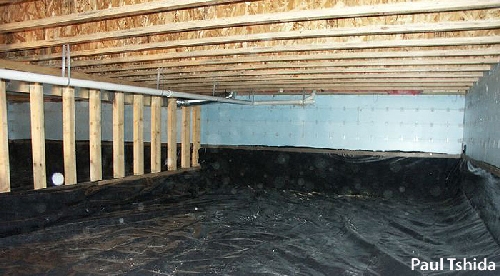If your home has a crawl space, now is a good time to inspect it for any signs of moisture accumulation. A surprising number of homes with moisture problems such as wet windows, mildew on the walls and ceiling, or damp attic insulation can trace their moisture source to a damp crawl space.
Every crawl space should have a ground moisture barrier installed over the bare soil. A lot of moisture travels from the ground into the air, even in crawl spaces that appear to be dry. Bare ground can also allow soil gases such as radon, petroleum vapors, or fertilizer residues to enter the home.

If you find bare ground in your crawl space, you should install a ground moisture barrier. The most common type is a continuous sheet of polyethylene plastic. It can be either clear or black, and should be at least 6 mils (one mil = 1/1000 inch) thick so that it doesn't tear. An even better option is reinforced polyethylene, a tough white material that is stronger than normal polyethylene. Either type should be overlapped at the seams, and sealed with builder's tape or construction adhesive to create an airtight barrier. Cut your ground moisture barrier plenty big so it can be turned up the foundation walls a foot or two. Seal these edges to the foundation with construction adhesive.
You'll need to find an access hatch into your crawl space, either from the outdoors or through the floor inside your home. Wear good protective clothing, and bring a bright light so you can see to all the far corners. Watch out for protruding nails or other sharp objects, bare wires, or parts of the structure that you could hit your head on.
If your home already has a ground moisture barrier, be sure it is in good condition. You may need to repair any holes or tears, seal the seams, and seal the edges to the foundation. Your home will be drier and healthier as a result of these labors.
Both Residential Energy: Cost Savings and Comfort for Existing Buildings and Saturn Energy Auditor Field Guide contain more information about solving moisture problems.
